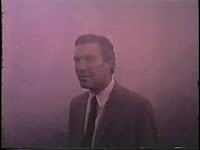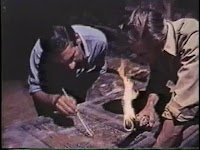Director: Frederick Goode
First released: 1968
Contains spoilers
Also known as The Hand of Night, this is a strange little beast that could have been much better than it was. That said, it managed to achieve some of its aims – one feels – but let itself down ultimately.
I should mention, before we get to the film itself, the opening credits. As well as being filled with skeletons and smoke, the astoundingly crap bat (pierced through the heart with a skeletal finger) is worth mentioning for it was, indeed, incredibly crap.
The film begins with a cemetery in thick fog. A man, Paul Carver (William Sylvester), moves through the fog. He comes to a funeral procession led by a man (Edward Underdown) that consists of three coffins (one clearly a child’s). He chases after them and enters a crypt where there is also a bearded Arab (William Dexter). He sees himself as a groom, with a bride (Avril Sadler). A coffin opens and she is in it. He sees lights and is in a car, out of control, he tells the others to jump.
Carver is on a plane to Morocco. The passenger next to him, Gunther – who was the undertaker in his dream – slaps him to wake him, whilst a stewardess (Angela Lovell) looks on in concern. Given him talking and mentioning jumping they think it is a flight anxiety dream. Gunther starts talking to him and Carver mentions that he saw Gunther and the Arab in the tomb in his dream. Gunther invites him to his home and, as they leave the airport, gives him his card. As a pretty blonde woman, Chantal (Diane Clare), meets Gunther, Carver wanders off.
He gets a cab to a Dr Miklos Czerny’s residence and rings the doorbell. A maid appears and tells Carver that Czerny died the day before. We next see Carver drunk in a bar. He tells the barman that he is a harbinger of death and then finds Gunther’s card in his wallet. Asking where the house is he is told that it is in the old quarter, not a place to go at night, but Carver is convinced no harm can befall him. He is followed by an Arab, Omar (Terence de Marney). When bats fly at Carver, causing him to fall, the Arab laughs at him and suggests that creatures of the light and dark are different and he must chose a side – the Arab then vanishes.
Carver reaches Gunther’s home and, as he waits in the hallway and we notice that a party is taking place, he looks at some artifacts on display. Amongst them is a ring. He is holding it as a Moroccan woman (Aliza Gur) comes down stars and absently slips it on his finger. He notices that she has no reflection in the hall mirror, though in his drunken state the meaning of this doesn’t click. Gunther greats him, he is an archaeologist and he and his partner, Leclerc, have just discovered a new tomb – Leclerc is the arab from Carver’s dream and Gunther believes Carter has second sight.
He is left to speak to Chantal, and mentions that his wife and children are dead. She bluntly asks if he killed them. Certainly he was driving the car when they had their accident and clearly he doesn’t believe he should have survived. Czerny was meant to help him – how, we never discover. He starts seeing the Moroccan woman, and her appearances seem tied to visions. Eventually he follows after her and ends up in an opulent palace with her. He discovers she is called Marisa, Omar is clearly her servant but the ring Carver accidentally took causes her pain. He passes out and wakes in the desert, where Gunther and a disbelieving Chantal find him.
It is actually Gunther who suggests that Marisa is a vampire, a servant of the night who strikes fear into men (rather than sucks their blood). Leclerc discovers that the tomb they have discovered is of a Princess called Marisa, who swore vengeance on mankind after she was buried alive in her tomb for infidelity. As the film develops Chantal clearly becomes a representation of the light and life and Marisa a representation of darkness and death. The film is an exploration of Carver’s delicate mental state, grieving and despairing that he lived whilst his family died.
Despite this (or maybe because of it, as they are real to him and, it seems, to those caught up in his trauma) the vampires do have rules. The ring was a talisman used to reflect light and thus ward evil spirits. Sunlight destroys the vampires, causing them to desiccate and become skeletons and a stake through the heart works well also.
As a psychological exploration the film is fascinating but struggles as Sylvester doesn’t seem a strong enough actor to carry that character exploration forward. This is the biggest shame of the film and that is not to say that Sylvester was not a solid actor, but solid is all he was. The effects also let this down. As fascinating as the dream sequence was, it all felt a little cheap (especially the skeletons) and as for the bats… awful.
It is a shame as this could have been something special, it tracks a course that would be, at least a little, similar to that explored in Blood Suckers and does a much better job of it. Yet it could have raised itself to so much more. 5 out of 10.
The imdb page is here.
Friday, June 25, 2010
Subscribe to:
Post Comments (Atom)























2 comments:
Oh! I've actually seen this! It was shown as one of those afternoon movie matinee things on t.v. when I was a child (that is also how I got introduced to Hammer Horror films).
A very cool little film, imho, using some of the trappings of mummy films in an interesting and undead way. Or so I seem to recall...
it isn't bad but it could have been so much more - it does need a dvd release, however, currently ropey dvd-r's are the only pay to get hold of the film.
Post a Comment